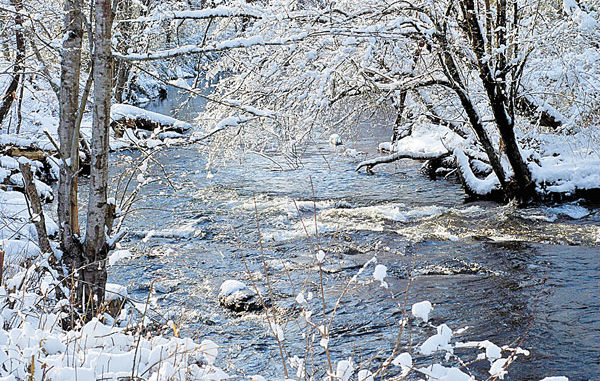
Trout activity slows to a snail’s pace in the winter, when streams are icy cold and often iced-over on the fringes. Hatches are fewer, and topwater action is minimal.
Fish have to eat, though, but most of the feeding takes place below the surface. From now until spring, nymphs are the best flies to use. Dry-fly fishing usually is limited to the warmest part of the day, between noon and 2 p.m., when, and if, the sun is on the water.
Nymph fishing is slower and requires more finesse than dry-fly fishing. Strikes often can be difficult to detect. Concentrate on the slower water in the deeper sections of a pool, The numbers may be fewer, but you’ll find a better quality of fish.
With fewer hatches coming off, nymphs are the type of food that trout, particularly large ones, see and prefer. When a big nymph floats past a trout, it sees a big mouthful of protein.
Roger Lowe of Waynesville, a veteran fly-fisher and former guide, said he often uses a dry fly such as a Royal Wulff as a strike indicator and a beadhead nymph as a dropper.
“The nymph should be small enough so that it doesn’t drag the dry fly down,” he said. For a No.16 to 14 nymph, a No. 12 or larger dry fly should be used.
Lowe ties a section of leader to the shank of the dry fly so that the dropper dangles about a foot below the top fly.
One technique used by many veteran mountain trout fishers is to dead-drift a weighted nymph. The nymph is cast upstream, allowed to drop slowly to the bottom of a pool or run, and then stripped in short spurts.
You have to watch for trout when you are dead-drifting. If you see a trout following the fly but not taking it, freeze. If the trout starts to turn away, give the line a jerk. That will make the trout think that the nymph is trying to escape, and it usually will strike
Willie Cope of Sylva, who guides on Great Smoky Mountains National Park streams, also is a proponent of dead-drifting.
“Dead-drifting a nymph through a deep hole or run is the best tactic for this time of year,” he said. “It can be very productive to suspend a nymph three to six inches above the bottom of a stream bed and let it drift through runs and riffles.
“Pay close attention to the drag and the effects it has on your drift. The less drag, the better you’ll do. This is where mending line really comes into play.”
Lowe uses bigger nymphs in the winter: No. 10s, 8s, even 6s.
“I’ll cast a large nymph such as a Woolly Booger across the current. When the line straightens out, I lower the rod tip and work the nymph through the water in short strips. It’s important to keep the rod tip down so that the nymph will stay deep,” he said. “Sometimes, you have to keep casting to the same place to get a strike. Keep your presentation slow to give the trout more time to study the fly.”
Some trout fishers prefer a weighted nymph rather than a beadhead. One technique is to add lead weight about six inches above the fly to give the nymph bounce. Others crimp the weight on top of the fly to get it down to the bottom of a pool.
“Weather, more than anything else, dictates the quality of fishing,” Lowe said, “and the time of day when you’re fishing is more important than the pattern you use.”
Once the sun drops below the tree tops, water temperature drops quickly, and trout hunker in to wait out the cold.
Not all winter fishing is limited to nymphs, however. Warm, sunny days can produce small but productive hatches of midges and, periodically, Blue-Winged Olives, which can be found on mountain streams almost any time of the year.
For winter dry-fly fishing, patterns should be small, nothing larger than a No. 20 or 18.
Winter has its drab, cold days, but it also has beautiful warm, sunny days that make trout fishing a pleasure.




Be the first to comment